Publish Date - June 14th, 2022
|Last Modified - September 4th, 2023
It’s not a secret that Python is a popular coding language. With the capability to automate repetitive tasks, extract information for files and even build websites – Python is an incredibly powerful language that is the backbone of AI, ML and a large majority of data science projects. As far as programming languages go, Python’s syntax is one of the easier object-oriented programming languages that you can learn.
In 2021, Python was one of the most utilized and known languages across hundreds of thousands of developers surveyed, only beaten by HTML / CSS and Javascript!
Therefore, to aid you in finding the best Udemy courses for python, I’ve compiled a list of unique python courses that I’m either doing, have audited or completed.
Top 10 best Udemy Python courses available to students
| Course | Ratings | Highlights | Frameworks |
| Most popular Python course by Jose Portilla | 4.6 / 5 – 476k+ ratings | Fundamentals of Python, Juypter notebooks, Decorators, Game build, OOP and classes: Note – I did this completed in October 2022. |
| Best Python Data Science course by Jose Portilla | 4.6 / 5 – 134k+ ratings | NumPy, Regression, Spark, Matplotlib, Classification, NLP, Plotly, Neural Networks, SVM |
| Best ML, Python and R in Data science by Kirill Eremenko and team | 4.6 / 5 – 174k+ ratings | Regression, Data processing, Classification, Clustering, NLP, Deep learning, Dimensionality Reduction |
| Best app building Python course on Udemy by Ardit Sulce | 4.6 / 5 – 63k+ ratings | Build Multiple websites and UI interfaces, Web cam tracker app, Web scraper, Android App |
| Best Python Django Full Stack Web development Course by Jose Portilla | 4.6 / 5 – 48k+ ratings | Build a Django website from scratch in MVC fashion. |
| Best Flask Python course by Jose Salvatierra | 4.6 / 5 – ~21k+ ratings | Build a RestAPI, SQLalchemy, work with logging, caching and authentication. |
| Best Python course for Financers (Investment models and fundamentals) by 365careers | 4.5 / 5 – 26k+ ratings | Matploblib, Panda, Regression and data visualization. Work with multiple financial models like Sharpe and Monte Carlo Simulation. |
| Best Selenium Webdriver course with Python by Rahul Shetty | 4.6 / 5 – 15k+ ratings | Unit and component testing, Build QA framework from scratch. |
| Best Automating Tasks with Python by Bluelime Learning Solutions | 4.3 / 5 – 39 Ratings | Manipulate PDFs, CSVs, images. Build an automatic email sender, a screensaver app and birthday scheduler |
| Best Python Hacking course on Udemy by Zaid Sabih | 4.7 / 5 – 18k+ ratings | Writer a spoofer, network scanner, code injector, packet snipper, bypass HTTPs, code malware and program a guess login script. Final project – build a vulnerability scanner. |
Note: There are affiliate links above and below to Udemy and other parties that I may receive commissions from. However, I highly recommend these products due to the fact that I’ve audited or taken them before. Please click through and support my website so that I don’t need to run Ads :).
I’ve also done a review on Coursera’s Python courses as well if you’re curious on how they compete. I plan on doing a Coursera vs. Udemy courses using Python as the main denominator.
Most Popular Python Course for beginners by Jose Portilla
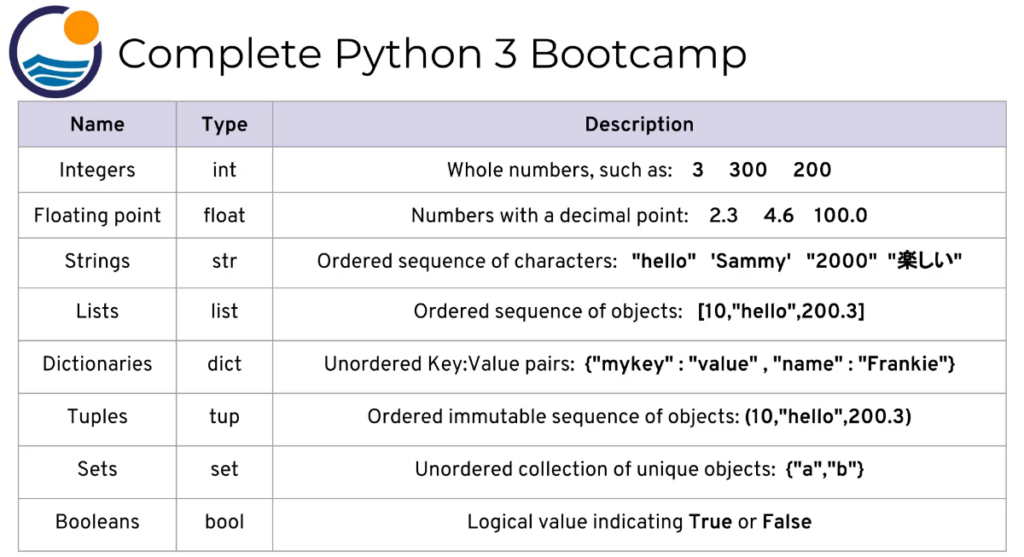
Overview of Jose Portilla’s complete python bootcamp: go from zero to hero
Note: I finished this course in late October 2022.
The introduction and onboarding is solid. You use Anaconda which has access to a number of libraries (Spyder, R Studio, Juypter labs and Juypter notebooks. He’ll also review Spyder and Pycharm, which are extremely popular IDEs.
Jose’s got most of his tutorials on GitHub – which you can fork the repository or just download the zip file. https://github.com/Pierian-Data/Complete-Python-3-Bootcamp. There’s even a lesson on Github.com and GIT.
Data types that are covered; Integers, Floating point, Strings, Data structures [Lists, Dictionaries, Tuples, Sets, Booleans].
Great walkthrough on how to interact with files. Functions like .read(), .readlines(), pwd are regular skills that you necessary for strong python programming.
zip(), inumerate(), mykey() and a number tools important for a programmer.
Will cover things like importing libraries and also creating your own functions, classes and methods.
After that basic stuff, he will dive into object orientated programming, error handling, decorators and generators before diving into actual applicable things with Python (web scraping, email creation, PDFs, CSVs and image manipulation).
Pros:
- Great summation slides which sum up entire chapters and are good to refer to. Also, Jose is a pro at walking through complicated subjects in the simplest way.
- Three plus hours of methods and functions (this was a great chapter).
- Fantastic milestone projects which appear at the perfect time during the length of the course:
- A tic-tac-toe game (utilizing functions only)
- The “war” card game (With classes, methods and tons of functions)
- A list of projects you can choose from (over 100)
- Good call outs to more unique modules, libraries and tool kits (Lambda, Filters, Maps, LEGB rule and other things).
- The coding exercises and quizzes are practical and help you build foundational skills.
- Great cadence to the flow of the course. It is structured like this: Explains a topic with slides -> Practice the topic in Jupyter notebooks -> Do a quiz / test / assignment.
- Lots of work in Jupyter notebooks, all of his work is in GitHub so you can fork the repo or download the ZIP and run it directly in Juypter notebooks (nice touch).
Cons:
- He has a 15 minute lecture on Anaconda and all of the different IDEs including web ones, this felt like it was unnecessary.
- Only 1.5 hours hands on looping or conditionals, there should be more practice on this.
- The course hasn’t been updated in almost 8 months, so some of the versioning is out of date.
- The final milestone was not really a milestone. It was more, “choose your own project” instead.
What students Jose’s students say?
Good course for beginners and intermediate students. Everything is well explained and the course is really fun, if you work around the problems/exercises, in your own way. I really do wish that it included a milestone project 3 though, with project logic explanation and solution, like Milestone Project 2. The lack of that is the only reason for deducting a star. But overall, if you want to learn Python from the scratch, this is the way.
Nevil Chrispin N. – 5/5 stars – August 2023
Jose Portilla is a wonderful teacher, explaining each concept in detail. I was happy to learn from him. I have already enrolled for his Data Science & Machine learning bootcamp. Many thanks, Jose!
Rajesh S. – 5/5 stars – August 2023
This course really helped in understanding python in very comprehensive manner and I am really grateful to the instructor Jose Portilla for this offering such as awesome course on Python.
Shriang K. – 5/5 Stars – August 2023
Verdict:
Ever need a 30 minute demonstration on the difference for RETURN versus PRINT function? Jose will walk you through the step-by-step difference between the two concepts. There’s also a great deal of exercises where you will just become a better coder all together. For example, the functions section and milestones were actually really hard, and I found myself Googling problems or outright giving up and checking his solutions. Ultimately, you will have that “Aah-ha” moment – due to the simplicity of Jose’s solution if you decide to cheat ;). Each project, task builds onto itself until you’re writing functions and classes yourself!
Check out the course on Udemy Now
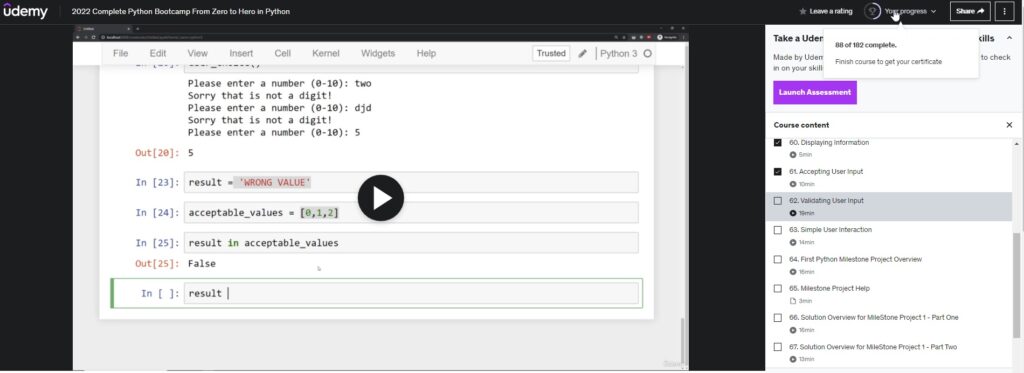
The milestone projects are awesome, because Jose will provide you with somewhat of a strategy to solve the project – but it’s up to you on how you combine the functions together or what modules you ultimately use. For an online course that’s under $20.00, it doesn’t get better than this. Pick up Jose Portilla’s course if you want to start learning Python.
Highest rated Python data science course
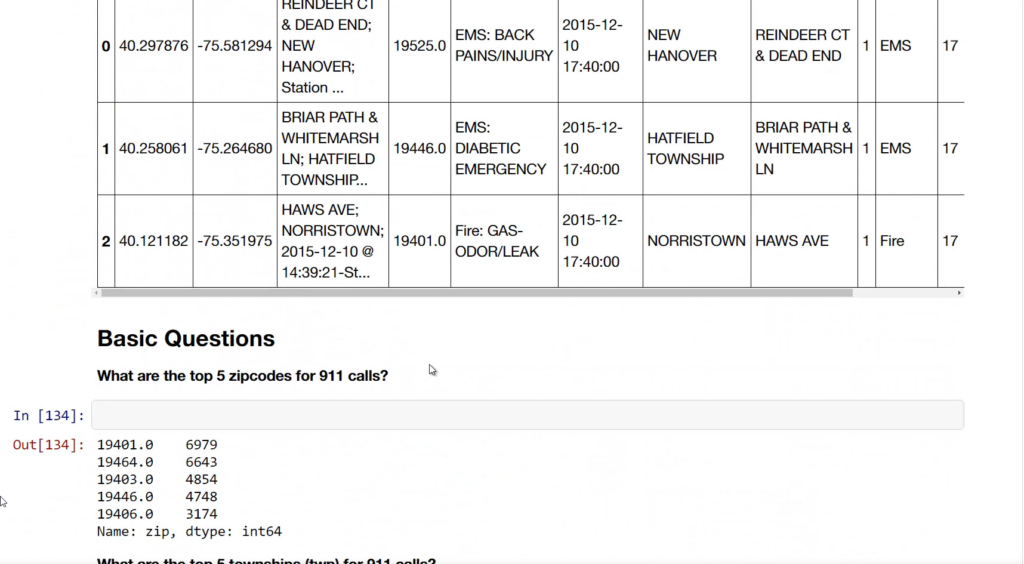
Overview:
Another Jose Portilla course with more “frills” than his “Zero to Hero” course, Jose focuses more specifically on the very powerful (and now popular) data science aspect of Python.
Like Jose’s crash course, you’ll use Juypter notebooks, to once again go through a number of basic to advanced Python concepts.
However, where Jose’s basic Python course was focused on new learners of Python – his Data science / Machine learning course focuses on the aspects of data science, which are not attended for Python newbies.
After a brief crash course in Python (1.5 hours), you’ll dive into data visualization with a number of different tools.
Tools covered:
- NumPy
- Pandas + exercises
- Matpotlib
- Seaborn
- Plotly and Cufflinks
- Graphically plotting.
Finishing off with a Capstone project, Jose then jumps into the statistics portion of data science / ML.
You’ll learn about neural networks, natural language processing, regression, decision trees and recommender systems.
The course finishes off with a brief but succinct course in Big Data and Spark.
Pros:
- Jose and Data Pierian’s style of teaching is great for newbies. Start off with a basic concept, demonstrate in Juypter notebooks, try some small practice problems and then build the work into functions or classes for later use.
- Good coverage on the different data modules and statistics (K Means clustering and regression)
- A bit of SQL in this course which is important for ML and Data science.
- Jose has a great instructor rating, has curated over 50 courses on Udemy and is clearly passionate about Python and Tech.
- Course is 25 hours (which is doable in a week).
Cons:
- This course was last updated in May 2020 (so it’s more than 2 years old now). There’s lots of evolution in ML, data science and AI.
- I wouldn’t say this is a beginner’s course, you must know python fundamentals to interact with the data visualization intuitively. Jose only gives a 1.5 hour crash course on Python, but there is so much more you can do if you have a stronger grasp on core python as a programming language.
Who’s this course for:
- A Pythonista or someone that wants to learn some data science / machine learning (more hands on).
- A “techie” person who has coded before (and might not know Python) but may know other languages like Javascript, Java or C++ (object orientated languages).
- A computer science major looking to start their python visualization journey.
- Someone who wants to start their journey in artificial intelligence (with data science and ML as a precursor).
Who’s this course not for:
- Someone who’s absolutely new to Python coding – this course is not for newbies.
- A person looking to master data science or machine learning – this course is a solid start in both, but you’ll breeze over it if you have experience in either disciplines.
What do the students say?
it touched on everything you need to learn about Python. I learned Python through school, and I have to say that I learned so much more about the libraries that Python offers. I think this will get everyone up to speed on their Python skill.
Eugene Tang Yucheng – 5 / 5 stars – September 2023
Great course! Even though i already had some knowledge of pandas and matjplotlib, the sections dedicated to these libraries were still useful and perfect to refresh my memory. The machine learning section is really well structured and the exercises and project are well realized.
Domenico P. – 5 / 5 stars – August 2023
This is an excellent course for beginners, easily understandable. i recommend this course for who interested to learn end to end on Machine learning and Data Science.
Sridhar S. – 4.5 / 5 stars – August 2023
Verdict
Another course that I’ve already started to take to help amplify my own skill in data science. The math portions of the course are a little light (some Coursera ML / data science courses offer better math foundational), but it’s a great cheap start to data science and ML with real python visualization. Also, I love that Jose tries to cover all of the main modules / libraries python uses.
If you’re looking for a strong start to kick off your ML / data science python adventure, and are not too fussy with learning current technologies and techniques, pick up this course.
Check out the course on Udemy Now.
Best ML python data science course with R
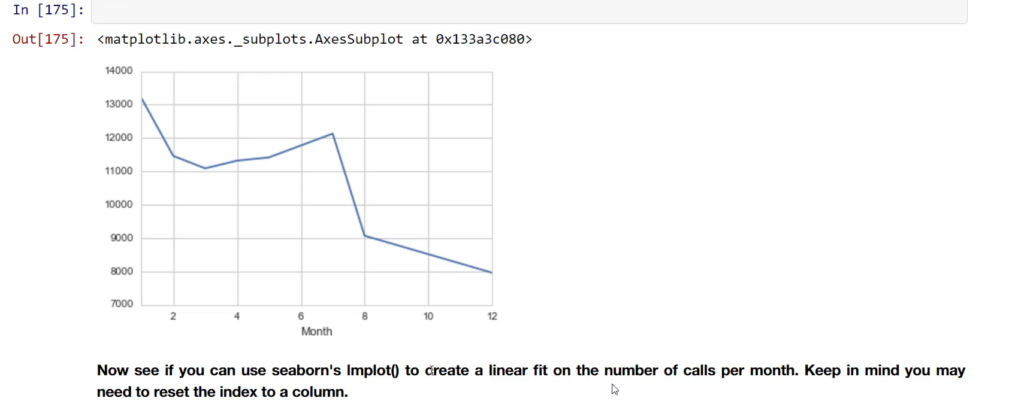
Overview:
A true machine learning and R / Python data science course – Kirill Eremenko and Hadelin de Ponteves look to bring an extremely comprehensive machine learning course to Udemy. For well over 50 hours, you’ll be subjected to the following rigors of the ML world:
- Introduction to ML
- Processing of Data in Python (importing and R
- Regression (Simple, Multiple, Polynomial, SVR, Decision Tree, Logic) and how to do regression in R and Python
- Classification (SVM, KVM, Naive Bayes, Decision tree, Random Forest)
- Clustering (K Clustering and Hierarchical Clustering)
- Association Rule Learning.
- Reinforcement Learning
- NLP (NLP in Python and R)
- Deep Learning (Neural Networks and Convolutional Networks)
- Dimensionality Reduction (PCA, LDA)
- Model selection and boosting
Having been updated June 2022 (when this article was first written), you can expect content that’s fairly up-to-date to ML trends in data science.
Pros:
- 44 hours of machine learning in R and Python.
- Lots of math which helps with the building of the algorithms
- Tons of in-depth practical vs. theoretical strategies for ML
- 3 hours of Natural language processing
- 6 hours of deep learning
- 5 hours of classification
- Course is modern with updates happening regularly
- You’ll work in Tensorflow (really sought after skill for ML)
Cons:
- This course may be too long, I am struggling to move from chapter to chapter. Only take this if you have the commitment to finish it
- A lot of users complain about the code being “Copy and pasted” which I am experiencing
- There’s 6 hours of math, if you don’t like math – you won’t like this course (and probably shouldn’t be doing ML 🙂 ).
- There are major issues with the code from SVR and onward.
- Due to this course covering so much, the authors end up glazing over concepts which beginners may struggle to know or understand.
Who is the course for:
Someone with Python and R skill looking to start ML
Who is this course not for:
A beginner (despite what they say), this course is really tough because of it’s length and the overall sophistication of ML and AI.
What do the student say?
A lot of great knowledge. I would only sometimes prefer to be more straightforward. I believe, the whole course could take half time without any important knowledge to be lost. Especially, the implementation part.
Dolphin consulting A. – 5 / 5 stars – September 2023
Overall, absolutely amazing course. Only recommendation would be to update some minor inconsistencies with versions of software’s that were made at the time of this course and current versions of software’s.Ex. CNN – Python (It’s called tf.keras.utils. now based on the official documentation). But overall, an absolutely amazing course, very well put and detailed and anyone at any level can get started in this field from this course!
Cameron B. – 4.5 / stars – September 2023
this course is by far one of the best machine learning courses around. it boost my confidence after finishing the course. I am forever grateful to Kirill, Hadeline and the team. You guys are amazing.
TUNDE AHMOD B. – 5 / 5 stars – August 2023
Verdict:
I’ve started this course and am only 12% of the way through, but am already finding issues with it. While machine learning is integral part of a data scientist’s job – so are skills in Python, mathematics, R and visualization.
For you to grasp these things, you need to have a moderate understanding of all of these aspects. Kirill’s course boasts that it is for beginners, but the video lectures while they’re good at explaining the concepts – fall short when actually executing the code.
Much of the code is copy and pasted, so you find yourself needing to Google how things actually work to absorb the concepts. While I may not get the certificate of completion, I still believe this is a good course if you have the drive to learn ML, the time and experience in Python, R and statistics. If you don’t, I’d tell you not to buy this course until you’ve built up that skill!
Check out the course on Udemy now.
Python mega course: build 10 real world applications
Overview:
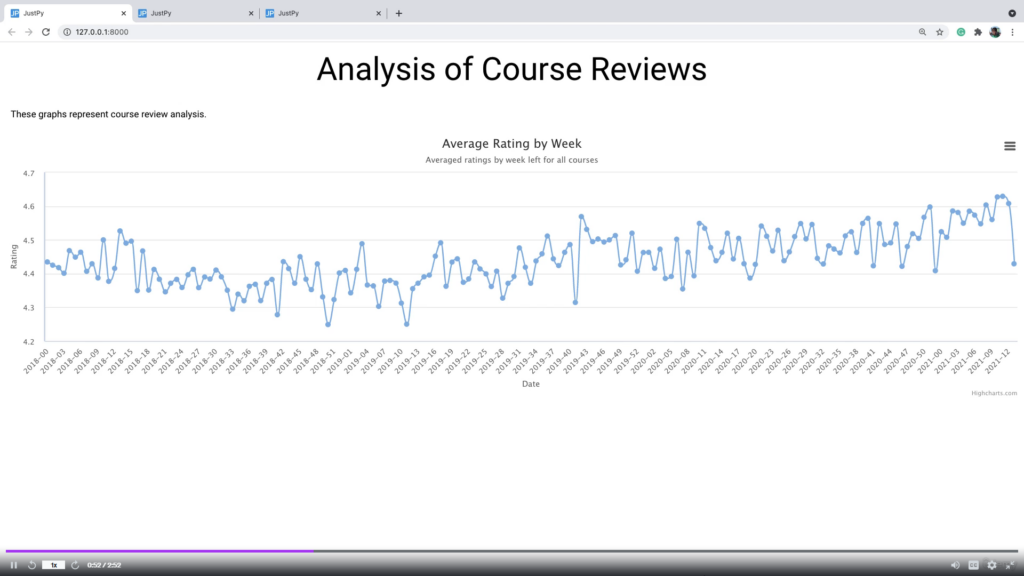
Another course that was also recently updated in June 2022, the purpose of the course is to give you practical understanding and skill on building web applications.
Using Python 3, you’ll start the course like any typical bootcamp – looking at functions, list comprehension, data types and structures, loops and conditionals. From there, you’ll learn how to extract data from with Excel CSVs and JSON using Python and then you’ll dive into the app building:
- Web Mapping with python – You’ll create an HTML map with Python that uses JSON data to add a map layer of volcanos and populations. Be warned – there is CSS / styling involved :).
- A nifty little controlling the webcam and detecting objects app – This is where you can use your web cam to track movement events. You’ll subsequently write all events into a CSV file (with timestamps).
- Data Analysis with visualization with Pandas and Matlab – This app is in two parts in one and one of the longest within the course. You’ll look at visualizing data and setting up monthly time series interactive graphs, and a pie chart!
- Website with Flask – With HTML and CSS, you’ll build a Flask app that you can deploy anywhere as your personal website.
- GUI apps and SQL – This app is a booking inventory system where a use can go in and make a reservation which is stored in a database. You’ll be using PostGreSQL as your DB language.
- Feel Good app – Building on your booking inventory system, you’ll create an application (an Android app) that a user can sign into, that has credentials – and can leave a rating on how they feel which will be tracked over time.
- Web scraping – You’ll extract “Div” elements in Python which you will be able to output on a CSV. Great for SEO people like myself :).
- You’ll build another website with Flask and PostGreSQL, where you store a user’s information from a website you’ve created – and it will send an email to the user.
- The first Django App – You’ll go from Django templates to building an entire website around Django’s translation feature.
- Last but not least, a geography app with Flask and Pandas – which will allow you to visualize population and location data based off a country.
Pros:
- It’s 32.5 hours of some pretty cool projects.
- The ramp-up is pretty good, with an “okay” amount of ramp up into the create of the applications.
- Recently updated (June 2022)
- You’re actually building applications that you can use after the course, or that you can put into your portfolio.
Cons:
- The Django courses and layouts are pretty simplistic, and the styling is from 2008. So while the functionality is sound, the layouts aren’t very appealing and wouldn’t work in our day and age.
- I personally would have liked to see more data visualization and task automation in this course since those are two of the things that python excels at.
- Like I said, the ramp-up is okay. I was able to follow along because this is my 12th Python bootcamp I’ve taken in my life (and I use it on a regular basis), whereas he spends 19 minutes on loops and 38 minutes on functions. Those could literally be courses by themselves. Therefore, I don’t think this course is for absolute beginners.
Who is the course for:
- A Pythonista looking to learn some new applications or skills.
- A computer science graduate looking to add a few apps to their Github portfolio
- A technical business person looking to build their own scraper.
Who is this course not for:
- A beginner who has never used Python – there’s just not enough bootcamp for you to build apps.
- Someone that hasn’t worked with HTML and CSS or in web development. 4 out of the 10 applications require HTML and CSS, as they are web apps. While more of the apps cater towards software development, you may find this course tough if you’ve never worked on a website before.
What do the students say?
In my opinion, this is the most comprehensive and the best intoductory Python course available on Udemy. Up until Module 7 it is perfect. Web-development and Data Science/ML modules are in a “hurry-mode”. Still awesome, but maybe this sections should be more developed and offered as an aditional course.
Rodrigo Pereira L. – 4.5 / 5 stars – September 2023
This is a good course for people who don’t know programming and are thinking of Python as their first programming language. Since I already know some programming, I can relate easily with the topics but I still learned new things when a solution shows a different way of solving a problem. I like Python now and I like the range of topics. At first, I was going through the course at normal play speed but I got used to x2 speed of watching and applying. The topics are clearly explained and interesting. If there’s something that is in the middle, it would be that at the end, things will feel somewhat short and that’s because it is only slow in the first half.
John Howard D. – 5 / 5 stars – August 2023
This course covers a much broader range of topics than most beginner to advanced courses. It is also covered each major topic in significant depth, providing concrete industrial uses for some of these techniques. Some exercises were simple, but did so in a way that allowed the user to abstract much more complexity that comes in the real world.
Jeffrey S. – 5 / 5 stars – August 2023
Verdict:
After auditing this course, I’ll probably end up taking it. I loved that Ardit touched on so many different types of applications, some that interact with hardware – and others that were completely web interface based. He also has you working with modules, HTML, CSS, SQL and Django – so this course is definitely more than a Python course. If you’re looking for a high-quality web app course, and you’ve done a few bootcamps or code in Python – this is definitely a must-have!
Check this course out on Udemy Now
Best Python and Django full stack web developer course
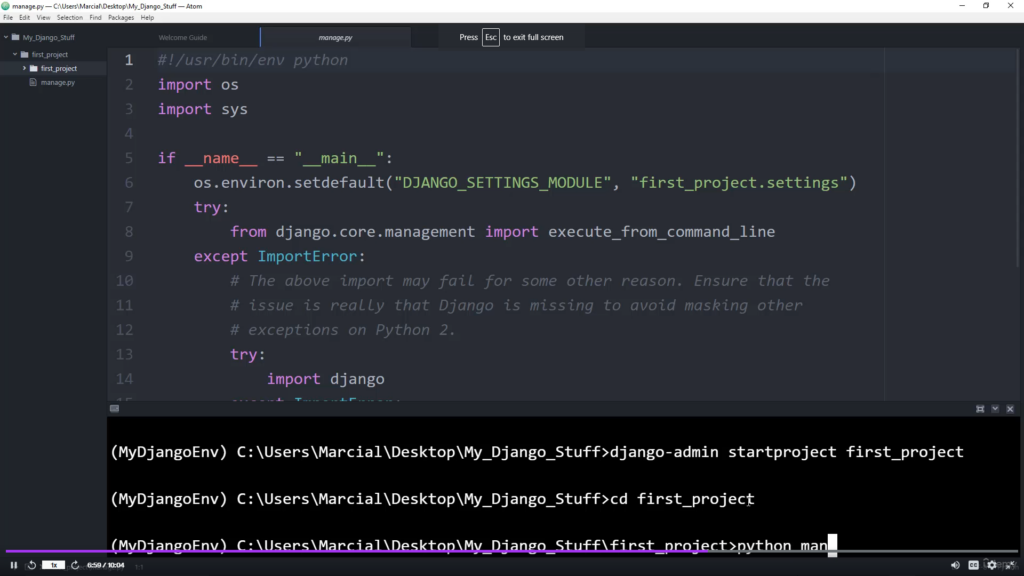
Note: Another Jose Portilla course 🙂 (you can tell I like his teaching style), and I’ve already reviewed the course in my best Udemy web development courses on Udemy. Below was the synopsis of the course!
Overview of Jose Portilla’s Course
For me, this course can be broken up into four parts:
- Vanilla HTML, CSS and JS (with one hour of JQuery), and a few hours of how the internet works (DOM, backend, and frontend systems).
- Python introduction (approximately four hours, which is only a drop in the bucket for python).
- Six hours of Django with some CBVs.
- Creation of applications.
With 32 hours of on-demand videos and a few downloadable sources, this course is great for giving you a kick-start in how Django, Python, HTML, CSS, and JS works.
Pros:
- Shorter than your average fullstack bootcamp (there’s individual React and Python courses that can go well over 80 hours).
- Jose’s communication skills are great (very articulated and easy to understand).
- There’s great usage of slide-specific instructions (see screenshot above) so that you understand what’s going on in the course.
- Good fundamentals of deploying code (the course begins with how websites work, and ends with deploying your first application)
Cons:
- The course is a little dry for my taste, and Django isn’t the most fancy or flashy coding language out there
- It’s a shorter bootcamp, and very one dimensional to Python and Django
- If you know HTML, CSS, JS, or JQuery – the first 15 sections are pretty redundant, even boring
- Course is a little outdated – it should be updated with more modern Python and Django stack.
Who this course is for:
- A technical business person who wants to understand how to build a Django or Python site from scratch (or help support their knowledge of how Django and Python applications function)
- Someone looking to start out in learning Django and python web development
- Someone looking to learn a new skill in web development
Who this course is not for:
- A fullstack developer who wants to learn Python or Django (take a dedicated course instead)
- An intermediate Django developer (this course will be useless for you)
- Someone who’s already skilled in HTML, CSS, JS, or JQuery. Instead, take a course like this by Dennis Ivy, which is specifically in Django if you want to learn it.
- If you’re looking to learn an in-depth data science Python course, you can check out my Python coursera list, or my upcoming Udemy Python list!
Verdict:
While it’s a great bootcamp, I don’t think Jose’s course is necessarily the penultimate for fullstack developers. Django and Python sites are relatively popular, but seem to be getting phased out for more modern applications like Next.js and older ones like Laravel. Ultimately, I feel like this course is more of a “follow-along” so that you can learn how Django and Python web applications work, and apply your learnings to a real project (hence the low amount of assignments and readings). This course was also last updated in late 2019, yet so many people are still taking it. This means it’s a quality course, but with information that’s most definitely out of date.
Check this course out on Udemy Now.
Best Python and Flask course
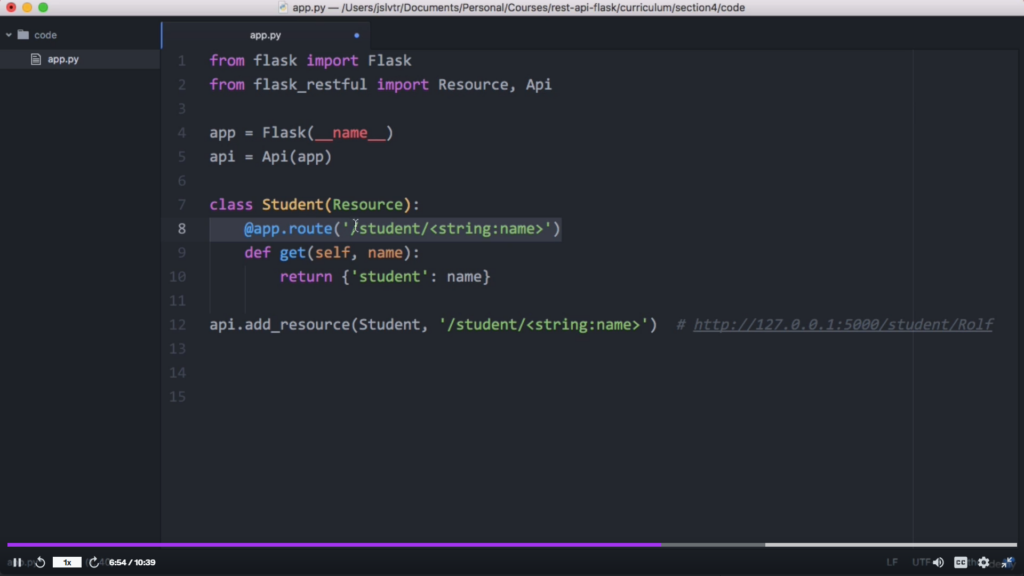
Overview:
I decided to add a Flask course because it’s an extremely popular web framework closely ranking behind Tensorflow and Django. In Jose Salvaterra’s course – you’ll work with APIs to authenticate and log user data. This course is mostly around building your first API in Flask and then subsequently building upon that API. The course highlights are:
- A five hour python refresher course.
- Build your first RESTful API
- How to store resources from your application into a DB.
- Deploying your app to Heroku and your own server.
- Security on your API
- Token refreshing and Flask-JWT
It’s a 17 hour course that’s been recently updated (April 2022). Therefore, if you have time to learn a new framework and want to play around with some APIs, this course may be for you!
Pros:
- A five hour Python course (double edged sword), but will prepare you for what’s ahead.
- Build your first REST API in python and flask (I bought this course, just for this)
- There’s a crash course in GIT which is nice.
Cons:
- A third of the course is refreshing on Python. That sucks, especially since this isn’t a beginner course.
- So you’re going to use SQL lite, instead of PostGreSQL – which isn’t comprehensive. Since you run into database management, it’s important that you know how SQLalchemy and SQL concepts like JOINs, Unions and keys work.
Who is the course for:
- A developer looking to start their API building experience in Flask and Python.
- Someone looking to learn Flask and Python together.
Who is this course not for:
- A beginner, someone who hasn’t worked with SQL or Python. You don’t need to know how APIs work, but you need to have legitimate programming experience.
- Someone looking for a course or data science or automation – you won’t find anything to help you in this course.
Verdict:
Another specialized course that isn’t easy and shouldn’t be attempted by beginners. IF you’re interested in Flask, take this course. ELIF you want to build an API in flask and Python (having skills in Python and SQL), take this course. ELSE – do not take this course, it’s a little specialized and isn’t meant for beginners.
Check this course out on Udemy.
Best Python course for business and finance
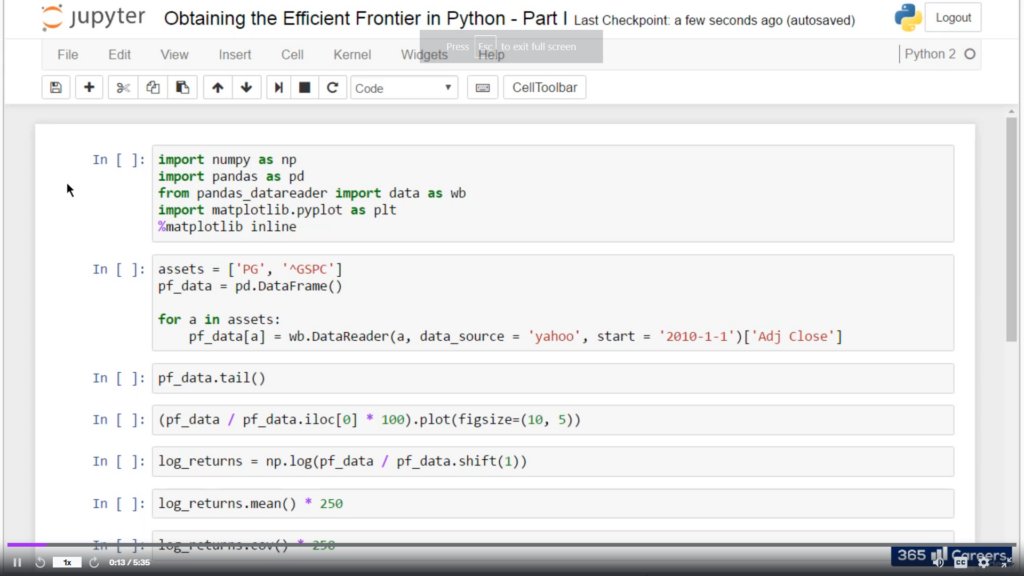
Overview:
A different course, specifically for financiers and those in business – this python course is a crash course in data visualization and those wanting to use python to visualize risk, correlation between stocks, different pricing and calculation models for stocks and other financial vehicles. Developed by 365careers, this course is only 9 hours but covers a lot of financial fundamentals.
If you want a crash course in financial modeling, and have a love for Python – this may be the course for you.
Pros:
- You’ll go over a number of packages (NumPy and Matplotlib).
- You’ll get to use Anaconda and Juypter notebooks for most of the work, really easy software to develop on.
- The course is only 9 hours, so it’s possible to do it within a few days.
- It has popular financial models like Sharpe Ratio, Capital asset pricing model (capm) and Monte Carlo simulation. You’ll learn how to code and build all of these in Python.
Cons:
- Once again, not an introductory course. This course is more of a specialization in visualization for financiers. You’ll have roughly 2.5 hours of Python review which is not enough to keep up with the creation of the graphs and models.
- I don’t know why Panda was an appendix, it’s crucial to many of the models within this course.
- This data is OLD and some of the videos are still using Python 2.
Who is this course for
- Computer science majors who want to get into the world of finance
- Business majors who want to learn how to use code to visualize their data
- A novice programmer who wants to learn some financial models
Who is this course not for
- A beginner in Python, I guarantee you – that you will struggle.
- An expert programmer – your better off taking a more advanced course for visualization.
What students say about this course:
Well Explained Course for a Aspiring WEB-Developer in Python but its old so atom editor is discontinued now and also the version of Bootstrap and Django is now updated.
Nishtha – 5 / 5 stars – August 2023
I knew a little about full stack development, but I’ve always wanted to learn how to incorporate Python. Perfect course for it, Thank you!
Garion M. – 5 / 5 stars – July 2023
The course is very good and deserves 5 starts. Despite that, I sometimes would prefer that the course presenter could be more objective in his lectures.
Rodrigo F. – 5 / 5 stars – June 2023
Verdict:
Personally, I would skip this one – and I actually returned the course. Here’s my reasoning; if you have any mediocre skill in python, you should be able to Google most of these visualizations. Many of them are basic and only need a 4 – 5 lines of Python wrapped in a function to run. The only way I’d take this course is if I was a beginner python developer looking to understand how financial models work in business.
Check this course out on Udemy.
Top Python QA automation course
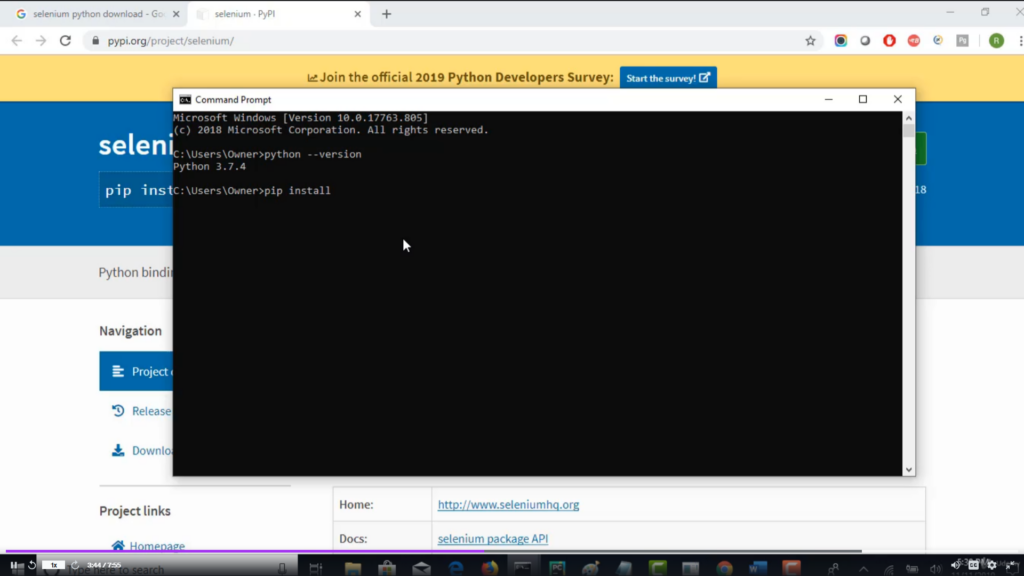
Overview:
As you know, one of the more beautiful aspects of python is it’s ability to automate tasks. The next three courses are all centered around that. This next course by Rahul Shetty is focused around QA automation testing with Selenium web driver (a popular automation framework).
The course is broken up into 4 sections:
- A basic deep dive into python basics – going over data types, flow control, OOP ,how to write to files and exception handling.
- How to use Web Driver API and Python to locate web elements and synchronizing the data captured.
- Working with Selenium and user interactions.
- PyTest, Logging and how to create a test framework with Jenkins.
There’s also a bonus on version control and GIT.
Pros:
- Very unique course, highly technical and interesting usage of Python.
- You’ll be exposed to unit tests, component testing, Jenkins and version control in GIT which are all important skills in a developers tool kit.
- They’ll teach you how to run tests in different browsers.
Cons:
- Once again, not a beginners course – this is meant for seasoned developers or someone who wants to learn QA automation.
- I would have liked to see a tutorial on how to use Postman since these tools all can work together.
- A lot of basic concepts are brought up – but not driven into.
Verdict:
While I wouldn’t take this course, it may be advantageous for a web developer or QA automation engineer to pick this up. The former because they can have a better understanding on how to create a testing framework, unit tests and automated testing – the latter because it’s their job to do things like this. With all of that said – I wouldn’t buy this course unless you’re looking at doing these two things.
Best Python course for automating repetitive tasks

Overview:
This course which less popular, looks at trying to help you automate tasks on your computer. After a very detailed 6+ hour crash course in Python, you will look at building every task functions and scripts like:
- Opening and reading files (text files, CSVs, PDFs).
- How to set-up and automate dates and tasks in calendars + create datetime functions.
- A script to manipulate and resize images in batch.
- How to merge, split, encrypt, add watermarks to PDFs.
- Web Scrapping (Scrappy)
- A screen break app
- A birthday reminder app
- Sending Emails from Python
Ultimately, this course is 17.5 hours with half of it being a crash course in Python and the automation portions only accounting for roughly 8 hours.
Pros:
- There’s actually useful automation apps in here. Most automation courses on Udemy are just glorified Python bootcamps.
- Course isn’t too long and it’s not too short.
- No 1-star ratings! First Course I’ve seen not have that.
- The instructor is methodical.
Cons:
- No downloadable resources 🙁
- It was last updated exactly a year ago.
- Not many people have taken this course.
Who is this course for:
Anyone!
Verdict:
While Al Sweigart’s automation course is more popular and has more reviews – I feel like this course had more useful real world skills taught.
Ultimately, I started this course because the reviews aren’t that bad and the apps are definitely useful in the real world. Auditing some of deeper chapters, there’s many interesting ways you can combine the apps to make something quite tangible. For example, you can totally create a screen break app that sends an email or SMS message to your phone when it’s done (same with the birthday reminder).
Start Automating on Udemy Now.
Best Python hacking course
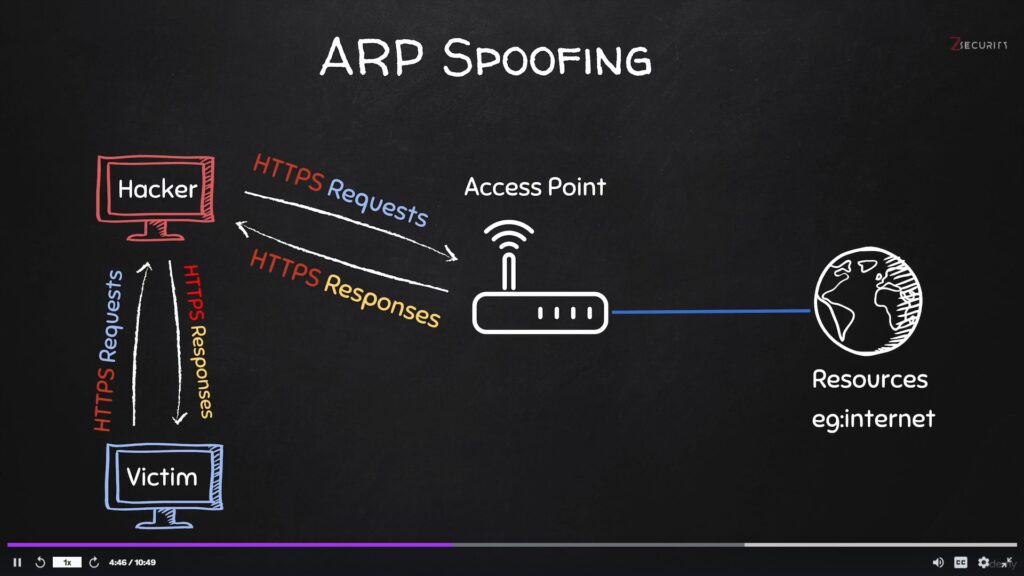
Last, but not least on the list is every developer’s favorite topic – hacking! This massive course has hours of video specifically on how to write Malware (keylogging, backdooring, packaging), hacking websites and creating a program to guess login information. While the purpose of this course is to create “ethical hacking” for pen testing – this course is can teach you some very neat skills if you’re skilled in Python.
Note: There is a very small python basics crash course in the beginning. It’s less than 1 hour – so this course is not for beginners.
Pros:
- This course is 25 hours of fun and interesting useful things you can do with Python.
- Creating a spoofer, keylogger and file injector are all cool SRE skills.
- You get to write Malware!
- Course was recently updated.
Cons:
- So the course says you don’t need previous skills, but looking at the topics and watching some of the videos – I don’t think that’s true.
Who is this course for:
- Anyone who wants to learn hacking that has some skill in Python.
- An SRE who wants to learn pen testing.
- A security consultant wanting to start their white hat career
Who is this course not for:
- Python beginners, I guarantee you – this will be tough to do for you if you’ve never coded in Python before. You can’t have a 1 hour tutorial on Python basics and then expect to write a multi-nested function that is over 50 lines of code.
Verdict:
Great course, with a lot of interesting concepts that are very applicable to the real world. As far as a Python tutorial goes on Udemy – you’re getting the best bang for your buck with this course. The course provider is very responsive, and a white hat hacker in his own right – so you can’t go wrong on that front.
Learn how to hack your friends now!
Conclusion:
Over the course of this article, I hopped to give you some ideas on different Python courses on Udemy. Hopefully, you’ve found a course (or courses) that you’ve liked and you’ll give them a try. Ultimately, this is all my own opinion as a lifetime learner. I’ve tried to give you intelligence on some more popular courses on Udemy so that you can save your money or spend it on something meaningful. I hope I’ve helped you further your career, your skills and let me know in the comments if you have any issues with this list or questions.
Hey, first of all a big thanks for you as you have published a very informative content on your website. I analyzed your website with mine and found that you have less traffic and less DA but your website looks like it has a lot of potential. Why don’t you rank your website for more keywords and earn more money.
Thanks again for the info!
hi – you done this course?
https://www.udemy.com/course/one-week-python/ it pretty good, what you think?
Also, nothing on typescript?
I like this course. https://www.udemy.com/course/learn-typescript/